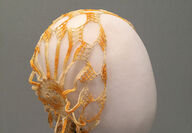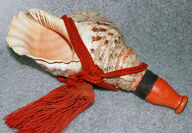Sorted by date Results 1 - 14 of 14
Picnics are a popular activity during the summer. To celebrate warmer weather and sunshine, this month’s artifact is a picnic basket. The word “picnic” has strong French origins, but it is difficult to pinpoint an exact origin of the word. However, the concept of picnics evolved from medieval hunting feasts, renaissance banquets, and victorian garden parties. In the United States, picnics can be defined as an event outside that involves food. The event may be potluck style or provided solely by the host of the picnic. As for the picnic baske...
This month’s Artifact of the Month is a Japanese abacus, also known as a soroban. The abacus is a counting device that allows its user to do quick mathematical calculations. The abacus used in Japan was adapted from the Chinese. The elements of both abaci are similar in construction. They both have top beads “heavenly beads” and lower beads “Earthly beads.” The key difference between the two is the Chinese abacus has two rows of “heavenly beads” while the Japanese version only has one row. This particular abacus can be dated between 1850...
Did you know that March 1 is National Pig Day and March 7 is National Crown Roast of Pork Day? It only seems fitting for March’s Artifact of the Month to be a handsaw used in a butcher’s shop. The saw is linked to Salt Lake City, but this saw has a richer history in Green River. It was used at the butcher’s shop in the Yellow Front Grocery. The grocery store was owned and operated by Kurt Hoffmann. He and Margaret, his wife, were German immigrants. Kurt came to Wyoming, first arriving in Rock Springs and worked for the Rock Springs Butch...

At first glance, it may look odd. What was its exact purpose? When would someone wear something like this? What is it exactly? This artifact is a nightcap, which was also referred to as a dust cap, boudoir cap, or bed cap. Nightcaps date back to the 13th century. They were initially worn in cooler climates in Europe as a way to keep the head warm while sleeping. Both men and women wore nightcaps, with men's nightcaps often taking the shape of a triangle. One of the most iconic depictions of a me...
August’s Artifact of the Month continues to focus on World War I artifacts in conjunction with the traveling World War I exhibit, “Home Front Posters of the Great War, 1917-1918,” from the Fort Casper Museum. This month’s artifact is a wool garrison cap from a World War I uniform. Attached to the hat are a pin and a badge. The pin’s logo is of the Corps Castle, which is the logo of the U.S. Army Corps of Engineers (USACE). The origin of the castle logo is unfortunately unknown. According to the USACE, “the official records of the Corps house...
This month’s artifact of the month is the first of a four-month series revolving around World War I and patriotic artifacts. The Sweetwater County Museum will host a traveling exhibit on World War I from mid-July to early October, to celebrate the war’s 100-year anniversary. We decided to design an accompanying exhibit as well as feature World War I artifacts for Artifact of the Month in conjunction of the traveling exhibit. For July, we are featuring a 48-star American flag from 1905. The flag has “GAR 1905” written on it. GAR stands for the...
Back by popular demand, the Sweetwater County Historical Museum is featuring the ventriloquist dummy used by Thomas C. Smith for May’s Artifact of the Month. This dummy wears a cowboy outfit, which is fitting for Wyoming. The dummy was made in London and the head and upper part of the body are constructed out of papier-mâché. Thomas C. Smith was an amateur ventriloquist in Rock Springs who took up ventriloquism after his cousin, Port Jackson Ward. Ward was a popular ventriloquist in England and performed for the royal family in 1909. Smith and...
Catching a cold can be a year-round occurrence and quite the nuisance when you catch one. Everyone hates the runny noses, sneezing and coughing that comes with a cold, and many people have go-to supplies for handling cold-related symptoms. For this month, the Sweetwater County Historical Museum is featuring a common product to deal with a pesky cold symptom: cough syrup. This cough syrup was manufactured by the pharmaceutical manufacturing company, Perrigo, in Allegan, Mich. They marketed this cough syrup as “White Tree Cough Syrup,” which con...
March’s Artifact of the Month is a little different as it features two artifacts instead of one. The first is a poem written by William J. Stroud, also known as “Rocky Mountain Bill,” titled “The Last Supper.” The second artifact is sheet music of “The Last Supper,” with music composed by Sylvan Donald Ward. As the title suggests, the poem depicts Jesus’ final days before his crucifixion, with references to Via Dolorosa and the Garden of Gethsemane. In Sylvan Donald Ward’s composition, we see that the song is in E-flat major with a ¾ time sig...
February is typically known as a month of romance due in part to Valentine’s Day on Feb. 14. For this month’s Artifact of the Month, the Sweetwater County Museum is also getting into the romantic mood, but in a different sense. The featured artifact is a booklet titled, “The Romance of the Smithsonian Institution: Vividly Portrayed by Its Scholars in the Smithsonian Scientific Series.” It features the Smithsonian Institution Building, also known as the Castle, on the cover. The book was printed in 1942 as part of an intended series. While a...
It’s the holiday season, and many people are buying toys for the children in their lives. For December’s Artifact of the Month, the Sweetwater County Museum is featuring a toy airplane from the 1930s, which was donated to the Museum by Robert. N. Malonek. This toy airplane is the NX-271 model from a collaboration between Little Jim Playthings and J.C. Penney. It is a tri-motor model airplane and is made from pressed steel. The popularity of airplanes soared after Charles Lindbergh’s famous transatlantic flight in 1927, and also with the incre...
Since November 2016 marks another election year, this month’s artifact of the month comes from political advertising for elections. This artifact is a matchbook advertisement from John Warden Opie’s re-election campaign for County Coroner around the 1940s. The matchbook reads, “Let’s all vote for & support your present County Coroner J. Warden Opie, Democratic Candidate, The Logical Man For The Office.” Opie originally hailed from Oroville, Wash., where he started his career in the funeral business. He moved around to other towns such as W...
This month’s featured artifact is a Geiger counter donated to the Sweetwater County Historical Museum by Arnold M. Hannum. Geiger counters are used to detect ionizing radiation, and similar objects have been used in the uranium mining business in Wyoming. This particular Geiger counter was produced by the Eberline Instrument Corporation of Santa Fe, N.M., and was copyrighted July 29, 1966 as the PRM-4 model. The Eberline Instrument Corporation was established in 1958 by Howard Clayton Eberline, a former employee of the Los Alamos Scientific L...

Among the collection of artifacts housed at the Sweetwater County Historical Museum is a large shell horn. With a red and black wooden mouthpiece installed on one side and tied with a dark red cord, the shell's inclusion in a small Wyoming museum's collection may seem odd to some. The shell horn is known as a horagai and it originates from Japan. The horn is constructed from a triton shell and red cord wrapped around from the mouthpiece and shell is known as the kainō. Tassels at each end of the...